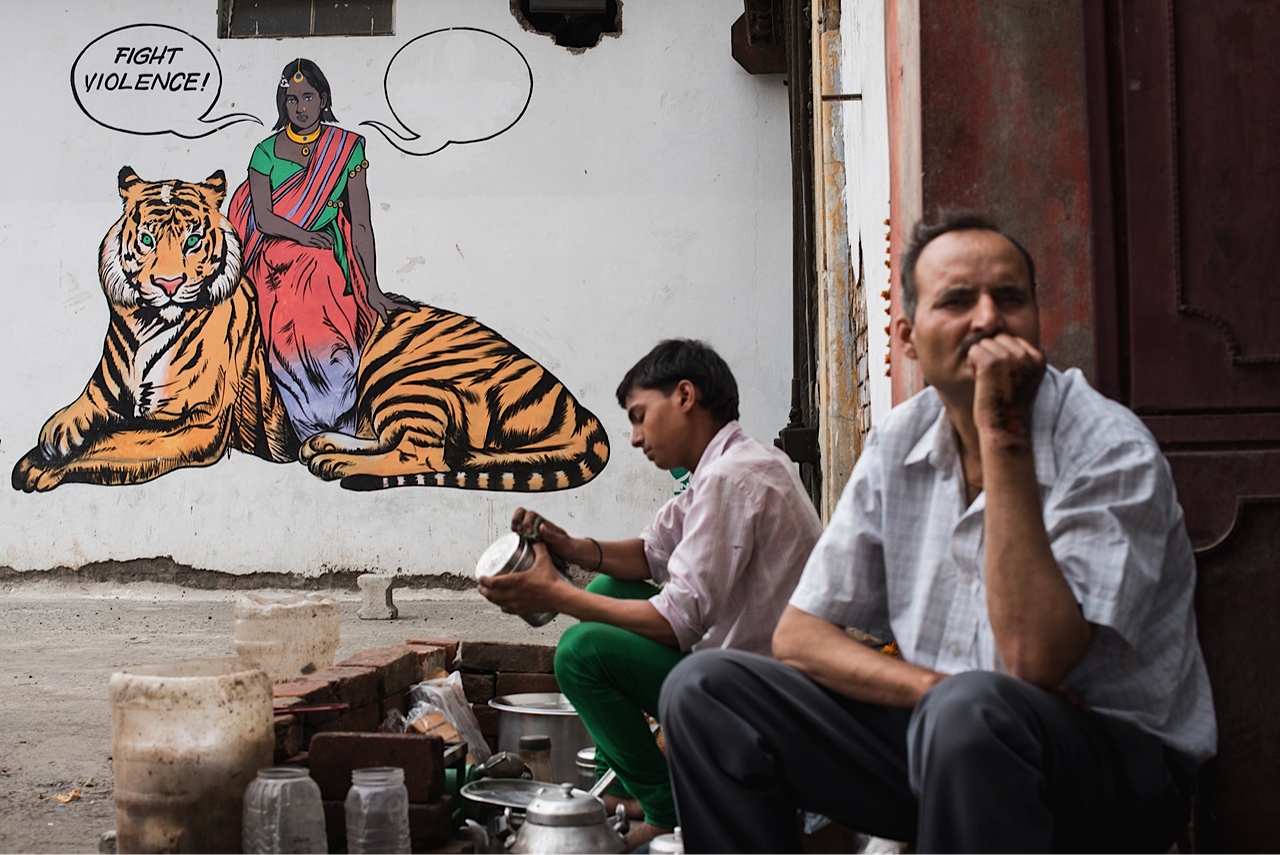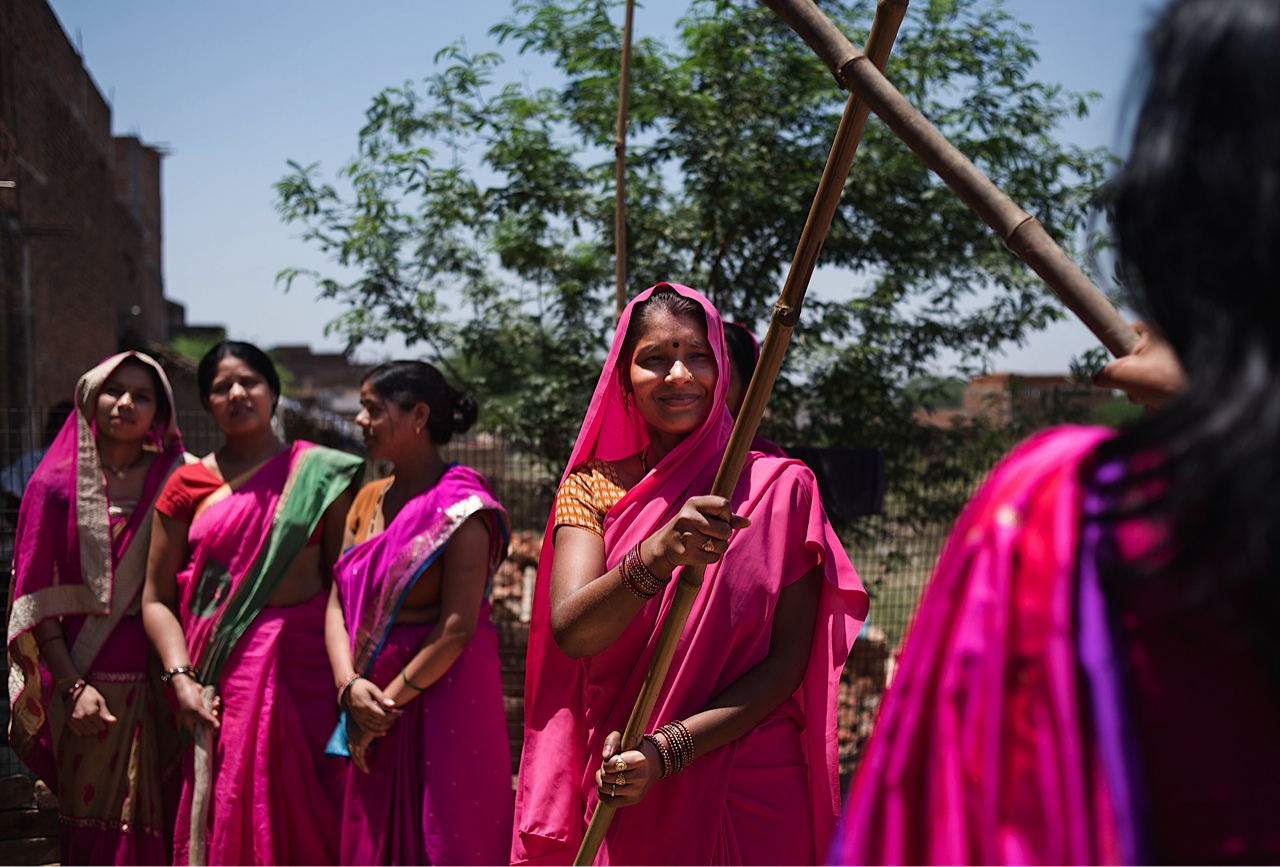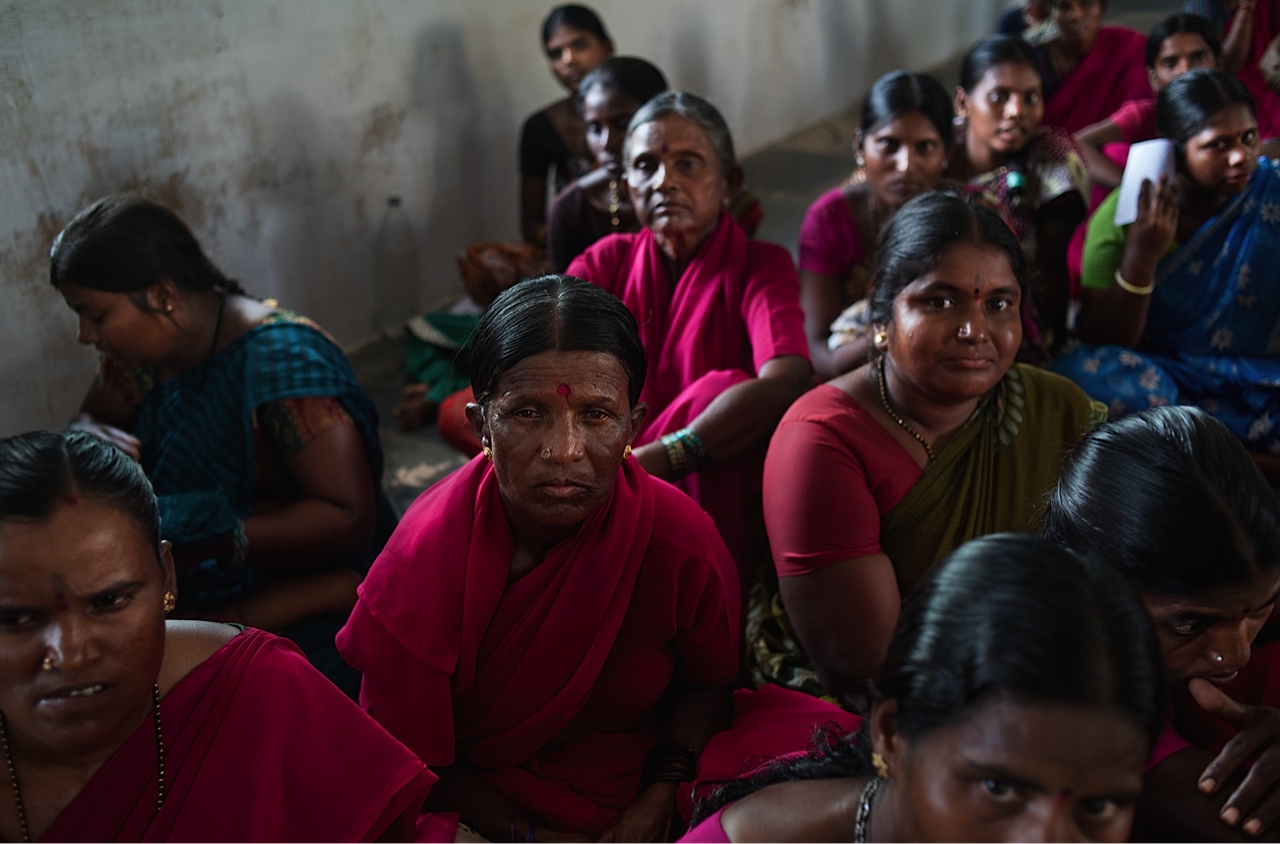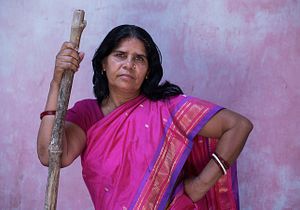They wear a pink sari, wield a stick, and don’t hesitate to resort violence in their fight for women’s rights. They make up the Gulabi Gang, an association created by Sampat Pal to eradicate gender violence in a country where women are discriminated against even before birth.
Janki Devi’s relationship with the man she fell in love with was never easy. She was only 15 when she met Anand Kumar, a twenty-something to whom a few months later she lost her virginity, but both sets of parents opposed the union outright. Not surprisingly, in rural areas of the Indian state of Uttar Pradesh, as it happens across the country to varying degrees, romantic relationships are a matter arranged between two families regardless of feelings. They become a mathematical operation where caste, economic status, and political relations between the two clans are considered. Love, they say, comes with time and routine.
For Janki and Anand that equation did not provide the desired result, so their parents demanded that they cease to see each other. Instead, the couple decided to marry in secret and present it as a fait accompli. Thus, as tradition dictates, Janki finally moved into the home of her in-laws in 2006. And so began another nightmare for her. For unknown reasons, because she was never allowed to access medical tests, she was unable to conceive a child. So, on February 23, Anand’s parents doused her with gasoline and set her on fire. Neighbors managed to take her to the hospital, but that night Janki Devi died. Despite the complaint lodged by her parents, the police did not investigate and the media showed no interest in her story.
Janki is just one of the more than 300,000 women who each year suffer from the different forms that gender violence takes in India, a country where, according to official statistics from 2013, a woman is abducted every 10 minutes and one is raped every 20 minutes. And these figures still fail to reflect the country’s situation in all its cruelty. Because, as Doreen Reddy, Women Programs director for the Rural Development Trust NGO, explains, “for every case reported there is at least another one who is suffered in silence.” In fact, according to a government survey conducted between 2005 and 2006, 51 percent of men –and, surprisingly, 55 percent of women – justify domestic violence in some circumstances. The one most cited is disrespecting the in-laws, followed by postponing housework and arguing with the husband. And this is not just poor rural sentiment: The Supreme Court itself ratified in February that rape within marriage is legal.

At the heart of Delhi city, a graffiti against women violence is displayed with the Goddess Durga, also called Divine Mother, who represents the power of the Supreme Being that preserves moral order and righteousness and protects mankind against evil, hatred and jealousy. Source: Miguel Candela
Many also believe that an infertile woman is a useless animal, and some, including those who killed Janki, even feel entitled to take matters into their own hands. But her father, Dinesh Prasad Panday, believes there is no justification for murdering a woman. So, after unsuccessfully trying to get the police to prosecute Anand’s family, who belong to a higher caste and have contacts among local government officials, he has decided to seek justice in another way: He has taken the case to the headquarters of the Gulabi Gang, also known as the Pink Sari Sister’s Gang, in the small town of Badausa. Created in 2006, this association of about 400,000 women across India has become the terror of rapists, abusers, and corrupt policemen. All because its founder, Sampat Pal Devi, doesn’t mess around.
She is an energetic 53-year-old woman who receives Panday on the ground floor of the three story building she owns. Frowning, she checks the photographs that the father took in the hospital, among which are terrible images of the burns that Janki suffered, and listens carefully to the story. A few minutes later, she grabs her old Nokia phone and calls the police station where the Vice Chief of Police Ajay Kulghat has even refused to receive Panday. Pal needs only to pronounce her name for someone across the line to get police attention. And they are going to hear what she has to say. Shouting, she warns that, if they do not promptly open a proper investigation into the death of the young woman, they will have to face a crowd of enraged women at the door.
The Law of Talion
“I don’t advocate violence, but there are times when that is the only way to fight,” Pal explains straight after finishing the call. “There are people with whom words and arguments are not enough,” she stresses pointing at the photo of Janki. That is why those who join the ranks of the Gulabi Gang wear a distinctive uniform that now everyone recognizes: a pink sari – the traditional Indian dress. With the 500 rupee ($7.50) annual fee they also get a stick to carry around at all times. “It is intended to protect us, but also to threaten and, if necessary, to beat up the abusers,” says Pal. That is what she did for the first time in 2002, when she found a man beating a woman in the street. Pal decided to intervene and was abused too. So, the next day, she managed to convince five more women from her village to implement the law of talion. Her strategy yielded good results then and hasn’t changed much since: A few months ago she accused a judge of the Atarra court of inaction against gender violence and dragged him out to the street. That’s also why she has a dozen pending trials against her.

Gulabi gang members train with their 7 foot bamboo sticks which they use to defend themselves against men. Source: Miguel Candela
But it’s obvious that Pal’s methods work: Half an hour after the first call, the police commissioner agrees to meet with Panday, who leaves grateful and with renewed hope. But Janki’s isn’t, by any means, the only case the activist is dealing with. Every day Pal gets several, and with most of them she is unable to contain her anger. After all, she understands the pain. The daughter of poor peasants, Pal was forced to marry a 25-year-old man soon after her first period. “I was taken out of school when I didn’t yet know how to write and read, and I became a slave in the house of my in-laws,” she recalls.
Three years later, at 15, she gave birth to the first of her five children, who arrived in a row, “one every year.” But her strong character trumped the hardness of the situation and she made her in-laws respect her. Soon, she found out what she really wanted to do in life: “I became interested in the work of groups who said they were seeking women’s liberation. But I realized that they could not meet any of their goals. People laughed at them,” she says, as other Gulabi Gang members join the conversation. “I know my position seems very radical, but sometimes the stick is the only way to achieve change.”
Although her unorthodox vigilante methods attract the most attention, Pal has also tailored more traditional programs to get beyond the specific cases arriving daily and achieve a greater impact in the community. “Society will only change if we eliminate the inherent subordination of the role given to women. And this is a revolution that has to come from us. Therefore, besides having established self-help and legal counselling groups to address individual cases, we focus mainly on programs to achieve their emancipation. From savings funds to events with companies, where women can be hired,” she says.
Pal’s goal is very clear, and it is so ambitious that it sounds like a utopia. “Eradicating child marriage and the dowry tradition, act firmly against domestic violence, and promote the empowerment of women through education and social awareness,” lists Pal. “Many argue that those are rights already protected by our Constitution, but the problem doesn’t lie with the law, which is good, but with its implementation. We live in a violent patriarchy that permeates all institutions, especially the police and politicians at the highest level. If we women don’t save ourselves, nobody will,” she concludes. Around her, everybody nods silently in agreement.

A group of women at a sangham start to organize themselves to fight against domestic violence and child marriage in the state of Andhra Pradesh. Source: Miguel Candela
Discrimination From the Womb
Women in India are discriminated against even before birth. Technology to determine the sex of a fetus has now made it possible for people to make a living in rural areas by taking an ultrasound machine from house to house, looking for pregnant women. If they discover that it is a girl being developed in the womb, many women are forced to undergo an abortion. So while the world averages 106 boys born for every 100 women, in India that number is 112. It is estimated that in the last three decades 12 million girls haven’t been born due to the practice of feticide.
Fortunately for Vanita, a 21-year-old woman living more than 700 miles south of Badausa, in the town of Anantapur, her parents didn’t know she was a girl until she was born. Now she’s the eldest of five siblings and a good example of the drama Indian women experience. She suffers triple discrimination: for her physical disability, for belonging to a tribal minority, and for being a woman. But her nightmare didn’t start until she was 15 years old.
“It was when my mother died. She had had an accident on an auto-rickshaw [a motorized tricycle used as a taxi], and they could not save her,” she recalls sobbing. “My father only took three months to marry a sister of my mother who abused me and with whom he already maintained a secret relationship. Then, everything changed. My father told me I had to leave school and start working, so I went on as a day laborer, where I was paid 100 rupees ($1.50) per day. But because I didn’t approve of his relationship with my aunt, she decided to get me out of the way by marrying me to another uncle, much older than me.”
Indian law allows such marriages between relatives, but Vanita refused. To force her into it, her stepmother found a too common solution: She asked Vanita’s suitor to rape her so she could not reject the marriage after losing her virginity. “Premeditated rape is one of the most common formulas, even with children under 12, to force a girl to marry a particular man or break a relationship kept for love against the parents’ wishes,” says Sampat Pal.
But Vanita discovered the plot and decided to preserve her dignity. “I crushed the crystal bracelets I usually wear and drank the powder to kill myself,” she says. Doctors managed to save her life, but ever since then her family has turned their back on her. “They’ve now found another suitor. He’s already married, but as he has no children he may marry again. I don’t like him. He’s fat and old. But I know it’ll be difficult to find someone who will accept me with my disability.” As a teenager, Vanita suffered an episode of brain fever that caused paralysis in her right hand and left leg. It is not very obvious, and hardly affects her mobility, but in rural India it imposes a heavy social burden. “I’ll end up marrying whomever they choose for me,” she laments.
Although most marriages in rural India have nothing to do with the spouses’ feelings, Sampat Pal is against divorce. “It’s a way to turn women into a commodity. Men need to understand that women are not like sandals, that you can change whenever you feel like it,” she asserts. Beside her, Sayah Bana, a 22-year-old Muslim woman, nods. Two years ago she was repudiated by her husband, a school teacher who physically and psychologically abused her and who decided to marry again, illegally, with another woman.
“He told me to return to my parents’ house with our two children,” Bana recalls. “I went to the police to report him for bigamy, but everyone ignored me, so a few months ago I decided to join the Gulabi Gang to assert our rights.” Despite the beatings her husband gave her, especially when he was drunk, she doesn’t want to divorce. Bana demands that he leave his second wife so that they can continue living as a family. “We didn’t make any progress with the case until we got the sticks out and we stood in front of the police station,” she says. “Now we will see what the judge decides.”
Unfortunately, justice can be the biggest enemy for Indian women. Suseelamma Nirugutta knows this only too well. She became a widow five days after giving birth to her second daughter, and had no way of earning an income. In an example of excessive naivety, she accepted the offer of a woman who promised her a decent job in the capital, Delhi, where she went with her youngest daughter, only eighteen months. “They took us to a house where I worked as a maid and in which I was offered alcohol and meat. I am a vegetarian and I never drink, so I declined.” But one day she was forced to eat and drink it, and she felt dizzy for three days. “They told me they would take me to hospital, but I ended up in a salon where I got a makeover and sexy clothes. There they threatened with killing me and my daughter if I didn’t do what they told me.”.
Nirugutta fell off the cliff of prostitution. But not for long. “They hid about 25 girls in a secret room during a raid. It was extremely hot and we could barely breathe, so a girl began to scream and the police found us.” In any other country, her rescue would have been a cause for celebration, but not in India. In fact, Nirugutta ended up in prison, where she was locked up for three years after the “madam” of the brothel accused her of trafficking women. Later she was admitted with her daughter in a special correctional center, where she met dozens of trafficked women jailed like her. They stayed until she was able to prove her innocence and was released. “But I couldn’t return to Chinapalli – the village of the state of Andhra Pradesh where she comes from – because I had no money, so I asked a policeman to help me find a job to save for a few months and return with some money so no one would suspect anything. My family thought I was dead,” she recalls.
Her story is shared by thousands of women, and not always with such a happy ending. In fact, a survey conducted three years ago among 370 specialists in gender issues revealed that India is the worst country in the G20 to be a woman. Statistics show why: 56,000 women die every year giving birth, their literacy rate of 55 percent is much lower than the 77 percent of their male compatriots, on average they earn 62 percent of a man’s wage, and 57 percent of teenagers – 52 percent in the case of girls – consider it acceptable to beat their wife. If that wasn’t enough, their lack of access to political power is clear in the Parliament, where only 11 percent of MPs are women.
Despite the black future drawn by the numbers, Sampat Pal is optimistic and says that the situation is changing. “Especially since Jyoti Singh was raped in Delhi. Her case has been a turning point in the perception of gender violence in society,” she says. She’s talking about the young medical student who, on the night of December 16, 2012, boarded a private bus in Delhi to return home with a friend after seeing a movie at the cinema. The occupants of the vehicle, friends of the driver who had been drinking and had taken the bus for a joyride, decided then to beat her male companion and rape her.
The men also brutalized the victim with a steel rod. They abandoned Jyoti and her friend in a ditch and Jyoti died after two weeks of excruciating agony in a hospital in Singapore. “The brutality of the case, and the fact it took place in the capital itself, have made many people aware of the seriousness of the situation. Therefore, we believe that her death was not in vain, and that it may have served as a catalyst for Indian women to get the respect they deserve,” Reddy concurs. “However, we are still far from achieving that.”
Zigor Aldama is the Far East correspondent for Vocento, the largest media group in Spain, and a contributor to El País newspaper, and is based in Shanghai. Miguel Candela is an award-winning Spanish photographer based in Hong Kong. Follow him on Twitter @miguelcandela_.
































